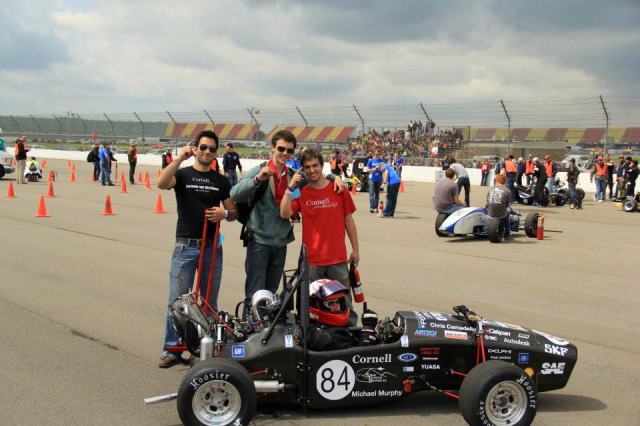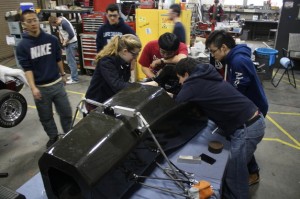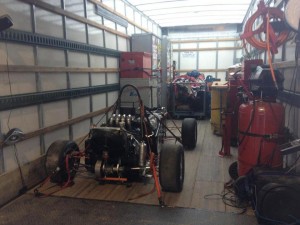Editor’s Note: This is Part 1 of Campus Pit Stop, a series of articles highlighting automotive engineering work being done on campuses across America. The series covers some of the schools’ participation in the Formula SAE and Baja SAE programs. For more information on these programs, please see our Campus Pit Stop introduction post.
Cornell University has been one of Formula SAE’s top contenders since being named FSAE’s Rookie of the Year in 1987. The Cornell Formula SAE team, known as Cornell Racing, has earned nine World Championship titles at FSAE Michigan and has won awards from the Society of Automotive Engineers, Road & Track magazine, Goodyear, and others.
While there’s little doubt Cornell Racing takes its status as FSAE heavyweight very seriously, the team decided to take a lighter approach to the competition in 2013.
For the 2013 FSAE competition at Michigan International Speedway, the Cornell Racing team created its first-ever, ultra-lightweight carbon fiber monocoque. The monocoque is the vehicle’s outer shell and incorporates the body and frame into one component, making it the main structural element for the car. It also served as the centerpiece for Cornell Racing’s focus on power-to-weight ratio as a competitive advantage.
“Our greatest mechanical accomplishment was the carbon fiber monocoque,” said Jesse Greene, Cornell Racing Formula SAE Team Leader. “The team invested over 3,000 hours to execute this single part. The monocoque used on ARG13 (the code name for the 2013 Cornell Racing FSAE vehicle) was Cornell Racing’s first-ever full carbon fiber tub—an enormous, but hugely successful innovation.”
Less is More?
The concept of weight savings as a competitive edge is nothing new. America’s “Big Three” car companies have offered one-off, stripped-down versions of their performance vehicle since way back. Ford, for example, created the legendary Fairlane Thunderbolt with weight savings in mind, making it a whopping 700 pounds less than the comparable Galaxie. Vehicle weight, gearing, and aerodynamics clearly play a huge role performance, yet gearheads still tend to make horsepower the “holy grail” for performance.
Cornell Racing opted for a different route.
Using the turbocharged Honda CBR600RR engine, differential, and ECU from the previous year’s car, the 70-member team looked for ways to make its exisiting horsepower go further and focused on shedding pounds from the vehicle.
“Using the same engine as the previous year, we were able to reduce weight by over 35 pounds from ARG12 to ARG13,” Greene said. “Weight savings were largely due to our first-ever full carbon fiber monocoque, a drastic departure from previous steel space frames.”
The process for creating the one-off monocoque required over 3,000 man hours. Using FEMAP and ANSYS design software, team members were able to determine and optimize a lay-up schedule for the monocoque, and because this singular piece must absorb the bulk of the chassis stress, the team spent a significant amount of time analyzing individual test panels and calculating torsional stiffness.
The manufucturing process required multiple trips to an autoclave, and Greene estimates at least 1,000 hours were spent inside the molds to lay down the actual carbon fiber. Once the monocoque cured, team members also spent a significant amount of time surfacing it and jigging ARG13’s suspension to it.
Although the monocoque was the most ambitious part for project, weight savings in other areas of vehicle helped trim ARG13’s overall weight to just 400 pounds (without the driver). For example, the team designed a custom turbine housing for the turbocharger. This housing improved flow system versatility and weighed significantly less than the stock cast-iron housing.
“We also experimented with different throttle designs as well as engine mapping to give drivers more control of the engine,” Greene said. “We also made use of ergonomic mock-ups to ensure our drivers would be comfortable in the car.”
Overall, Cornell Racing’s ARG13 took four months to design, 1.5 months to build, and three months to test.
The Results
Armed with three months of testing and improved data analysis from its MoTec ADL3 data collection and logging system, Cornell Racing headed to Brooklyn, MI to compete for another FSAE World Championship. The lighter design and improved power-to-weight ratio helped the team finish 6th overall in the competition—its highest finish since 2005. ARG13’s performance included a 1st place finish in acceleration and a 6th place finish in endurance.
Convinced the team is on the right track toward another World Championship, Greene says the team will continue to focus on weight and aerodynamics for 2014.
“We plan to lose another 10 to 15 pounds from the car as well as test and implement an aero package,” he said. “We will also continue to focus on the driver by improving the overall drivability and ergonomics of the car.”
How will breakthroughs in power-to-weight ratio and aerodynamics affect future vehicle design, performance, or fuel economy? It’s hard to know, but Greene is confident the future of the automotive industry will be in good hands thanks to programs like Formula SAE.
“Our team is modeled to run as a business, so awareness of budgeting, marketing, and public relations is continually reinforced,” he said. “The annual FSAE Michigan competition also provides experience working toward hard deadlines with a large group and serves as a real-world application of technical knowledge from classes.”
[important]
Cornell Racing ARG13: A Closer Look
Powetrain
Power: 95 bhp
Torque: 72 ft.-lbs.
Engine: Turbocharged Honda CBR600RR with BorgWarner KP-35 turbocharger
Transmission: 6-gear sequential pneumatic transmission
Differential: Drexler limited-slip
General Specifications
Custom-designed carbon fiber monocoque
Weight: 400 pounds
Weight distribution: 40/60 front-to-rear
65-inch wheelbase
Suspension
4-wheel independent double A-arm suspension
Penske 7800 2-way adjustable dampers
Hoosier racing slicks
[/important]




Go Big Red!